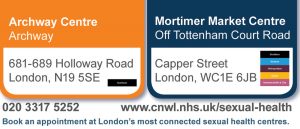Dr Laura Waters is an HIV and sexual health consultant at the Mortimer Market clinic and the Boyz Doc. With STI rates on the rise in the capital, here she outlines a few you should be aware of and explains how you can try to avoid them.
“Syphilis cases increase by 163% in London!” “Sexual health crisis!” These are just a few of the headlines from 2016. But how did we get here? What do you need to know? And what can you do to make sure your sex life is as fun, and as healthy, as possible?
The headlines are correct; many STIs are on the rise, particularly in gay men and particularly in London. The most recent detailed figures are from 2015:
• Over 5 years (2010 to 2015), syphilis cases in all Londoners increased by an astonishing 163%.
• 90% of London syphilis cases in 2015 were in gay men.
• Syphilis and gonorrhoea rates increased by around 20% in gay men in just a year.
It’s not all going up though – four clinics in central London (Homerton, Barts, 56 Dean Street and, where I work, the Mortimer Market Centre) reports about a 40% reduction in new HIV cases in 2016 compared with 2015. We don’t have full details for the rest of England, including other parts of London, but at a conference in Malta last week, Public Health England, who monitor STI rates, announced that provisional figures show a drop in new HIV in gay men in England of about 30%. These figures need confirmation but are promising indeed. A lot of the drop is being attributed to pre-exposure prophylaxis (PrEP).
PrEP almost certainly has had an important impact on new HIV rates but other key factors are likely to be the impact of treatment (someone with HIV but on effective treatment has zero, or close to zero, chance of passing the virus on to anyone else and we have more HIV positive people than ever on treatment) and better testing (a lot of new HIV infections come from people who don’t know they have the infection; in 2015 the proportion of people with undiagnosed HIV dropped to 13%, the lowest ever level, which will also have a beneficial effect on onward transmission – amongst gay men in London those unaware of their HIV infection has dropped to 1 in 10).
So why the rise in other STIs? Some of this is undoubtedly driven by a rise in condomless sex. Some have ‘blamed’ this on PrEP, but STIs were climbing before people were buying their own PrEP. Other factors include the risk of chem sex and geospatial apps like Grindr and Hornet which make hook-ups quick and simple. Although most STIs are curable there are other concerns.
1) STIs, especially those that cause ulcers (such as syphilis and gonorrhoea) may increase your risk of getting HIV.
2) Anything that causes rectal inflammation may increase the risk of getting hepatitis C.
3) Although uncommon, STIs can cause problems such as infection of the prostate or balls, or eye damage.
I’m now going to focus on some specific STIs that all sexually active gay men should be aware of.
Hepatitis A
Hot off the press, we are in the middle of a cluster of new cases of hepatitis A in gay men in some parts of England, including London. Many cases have been linked to travel to Spain, or contact with someone who has travelled to Spain recently. Hepatitis A is a virus that affects the liver and is spread through contaminated food/water or any sexual activity that brings mouths close to bums. All HIV positive gay men will be vaccinated but if you are HIV negative then you may or may not have been offered a vaccine. Guidelines recommend vaccine only during outbreak situations and as there hadn’t been one for some time most clinics stopped checking immunity and offering vaccine some years back. It is, as yet, undecided what all the clinics will do about the vaccine but it’s important to know how to protect yourself and what symptoms to look out for. Jaundice (going yellow) is common but not inevitable (about 30% of people don’t get jaundice) and flu-like symptoms or tiredness may be the first, and only, symptoms. For more information, check out Terrence Higgins Trust’s helpful advice via tht.org.uk/sexual-health/About-STIs/Hepatitis/Hepatitis-A.
Shigella
Shigella is a bacteria that, like hepatitis A, is spread through the ‘faeco-oral route’ (contaminated poo getting into your mouth), which can happen if an infected person doesn’t wash their hands properly before touching food or during sex. Shigella causes diarrhoea (typically with blood or slime in it), tummy cramps and fever – it’s usually mild enough to not need to see a doctor and simple painkillers, plenty of fluids and staying off work (until 48 hours after your last episode of diarrhoea) will be enough. If it’s more severe you might need antibiotics or even hospital admission. It’s better to NOT take anti-diarrhoea medication though since this can delay things getting better. You can reduce your risk by washing your hands after sex, taking care with oral sex after anal sex (change condoms or ask your partner to wash his penis before you suck him off), using a dental dam for rimming and using latex gloves for fisting or fingering. PHE and THT have a good leaflet which is available online.
Normal poo contains lots of bacteria but not shigella, which is only found in people with the infection (during symptoms and for a week or two after they recover).
Hepatitis C
Hepatitis C is another virus that affects the liver but unlike hepatitis A only around 1 in 5 people clear the virus themselves and the infection becomes chronic, which means it will only be cleared with drug treatment. The main risk factor for hepatitis C is injecting drug use but it can also be passed on through sharing snorting equipment and sex. Most of the early cases of hepatitis C in gay men were in those with HIV but we are seeing more and more in gay men who are HIV negative.
The important sexual risks are fisting, group sex and shared sex toys (which often overlap with drug use, i.e. chemsex, so it can be hard to know whether it’s the drugs or the sex that’s the issue) but we have been seeing cases, so far only in HIV positive gay men, where the only risk is condomless anal sex.
What you can do is to only use your own snorting or injecting gear (and that means everything used for injecting, not just the needles – many clinics provide ‘slamming packs’ for free), use condoms and, if you inject drugs, have high risk sex or are HIV positive, ensure a hep C test is part of your routine sexual health check up.
Sex should be fun, but STIs aren’t so fun; some are incurable (HIV), challenging to cure (hep C) or may become more difficult to cure (gonorrhoea). Have regular STI screens (every 3 months if you have had any type of sex with a new partner) and ask your partners to do the same. You can get FREE tests, treatment and advice at ANY sexual health clinic you choose – find one you like, test in person, test online, give your real name, give a fake name – whatever gets you tested and keeps you healthy!

Dr Laura Waters is an HIV and sexual health consultant at the Mortimer Market clinic and the Boyz Doc. Dr Laura answers your questions every two weeks in Boyz. If you have a question for Dr Laura please email her at [email protected].














